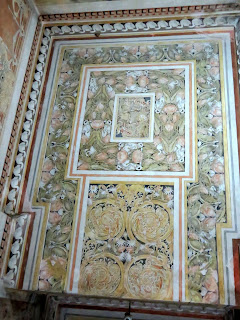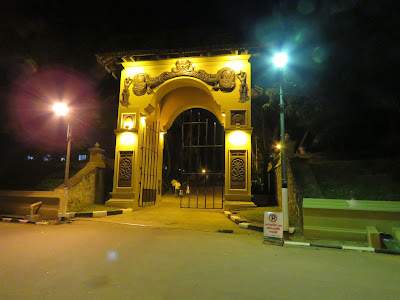
The luxuriant Kelainya Royal Temple standing on a high plain at the west banks of Kalyana River about 10km away from Colombo City, has a history of more than 2500 years. It is one of the most sacred and majestic temple site in Sri Lanka. The Temple was built at 3rd century BC at the site where Lord Buddha and Arahath Bikkus had stayed and gave sermons to Chulodara and Mahodra Nara Kings and his followers, in his third visit to Sri Lanka 8 years after his enlightenment. Sri Lanka enjoyed a prosperous golden era during this 3rd to 2nd century BC under the reign of King Kelanitissa and his grandson. Kelainya was then the capital city to the kingdom and through centuries, it had remained an important religious center in all historical periods, particularly in 14th - 15th century, when it was widely visited by monks from South East Asia. Unfortunately, the original buildings of the five storey Kelainya Royal Temple and stupa did not survived. The structures that restored in 13th century by King Vijayabahu III (1232-1236) and King Parakrama Bahu II(1236-1270) were also destroyed in 15th century by Portuguese. Most of the present structures were reconstructed in 1769 under the patronage of King Keerthi Sri Rajasingha (1746-1778).


A new shrine was built with an extended wing connected to the old shrine in early 20th century under the patronage of Mrs. Helana Wijewardana.. The new building was painted in a completely new style by a great illustrious master Solius Mendis who composed the modern Kelaniya Frescoes in subdued colors with paints he made himself from organic material. The ancient paintings was brought back to its original glory by his great job, which was considered as the best in the nation after Polonnaruwa Period. The renovation of the extension with modern paintings took twenty years to complete (1927-1946).


The large Temple Complex today comprises of Old Shrines, New Wing, Monks Residences and a 90 feet tall Stupa Dageha, which is a particularly important structure at site. The architecture of its grain heap dome retained in its original form of Dhanyagae shape. The gems studded throne on which Lord Buddha sat while giving sermons and some other utensils are said to have been enshrined inside the Stupa.


The Reclined Buddha Image House, Oth Pilinia Ge is the oldest section in the Temple Complex. The Hall enshrined with a golden image of reclined Buddha in the style of Kandyan era, was constructed in 18th century.


The decorative paintings in Reclined Buddha Image House depicting the important events in the life of Lord Buddha, the history of Buddhism in Sri Lanka and some local tales.



Even at night, devotees with families never cease to flock into the hall just to pay homage and offer Flowers to Buddha.


Kelainya Royal Temple is basically divided into four chambers : (1) The Reclined Buddha Image House Oth Pilinia Ge (2) Kings Image House Raja Pilima Ge (3) New Temple House Aluth Vihara Ge and (4) Golden Buddha Image House Ran Pilima Ge. King's Image House is one of the two 18th century structure. Most of the oldest Kandyan era paintings are found in this section.


The Kandyan old paintings inscribed in a medallion on the facade of sanctum in Raja Pilima Ge King's Image House, are dated from mid 19th century.


The paintings mainly based on the presence of important divinities when attending to Buddha including scene of Buddha descending from heaven, flying divinities, assembly of gods, divines and royal personages in various postures with clasping outstretched hands, paying respect to Lord Buddha. Such inscriptions and paintings so far, are not found in other shrines of Sri Lanka.


The seven stories in Jataka Buddhist Canonical literature of 4th century BC were also painted in the Frescoes.



The beautiful Kandyan styled paintings covered up the entire space at its dragon and lion arch Makara Torana in King's Image House.





An image of King Manjakkitha with a sword in his hand was among the old series of paintings in King's Image House.



The seven panels of ceiling at the entrance of Old King's Image House, bordered by ornamental designs and arts of plants and flowers, are related to the origins and evolution of universe. Four panels depict a Tree of Life symbolized the axis of universe and the other three panels that have the diagrams of twelve zodiac signs marked the twelve phases of annual cyclic movement of sun. The nine divine guardians of world directions and ten incarnations of Vishu were also part of its theme.





Golden Image House Ran Pilima Ge enshrines a golden seated image of Lord Buddha with snow crested Himalaya Mountains as its background. Its awesome.



Important historical events of Sri Lanka were painted on the walls of Golden Image House. It includes the bringing back of Lord Buddha's tooth relic from Kalinge of India by Princess Hemamali during the reign of King Kirti Sri Meghawarna (302-330), and the event of brought back the sapling of Sri Maha Bodhi from India by Sangamitta Theraniya. (Both of the two pictures I took did not turn up good)



The entire chamber of Golden Image House is fully painted with sophisticated ornamental designs.



The elegantly carved stone pillars at New Wing that linked to Golden Image House.



The courtyard of the Bhodi Tree gathered with many devotees though it was quite dark in night. They either circled the tree, offered light and flowers or milk and did their chanting or meditation just on the sandy ground. The Bhodi tree is grown with the original sapling from the great Maha Sri Bhodiya in Anuradhapura.



There are two terraces at the site of Bhodi Tree. Bodhi tree and Dageba Image House are at the upper accessible from four sides of the lower terrace area by flights of stone steps.



Kelainya Royal Temple is the venue of annual Duruthu Peraheraheld which is a glorious pageant held in every January to celebrate the visit of Buddha more than 2500 years ago.


No comments:
Post a Comment